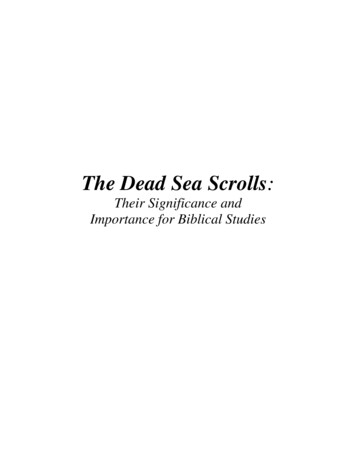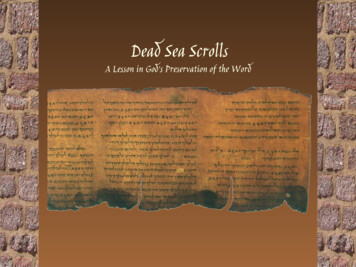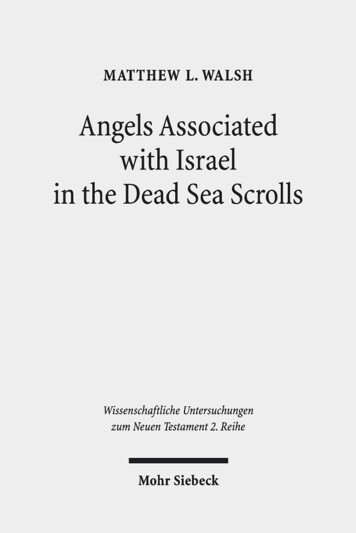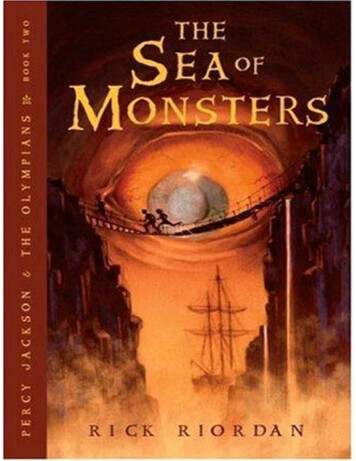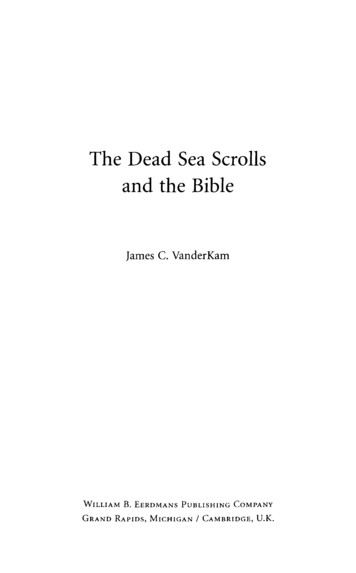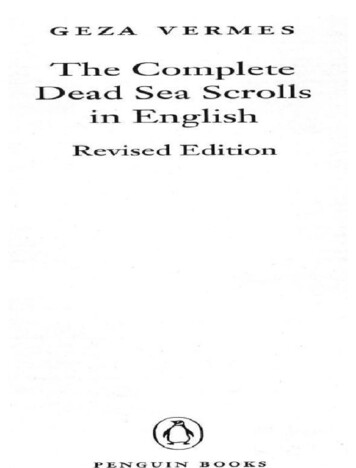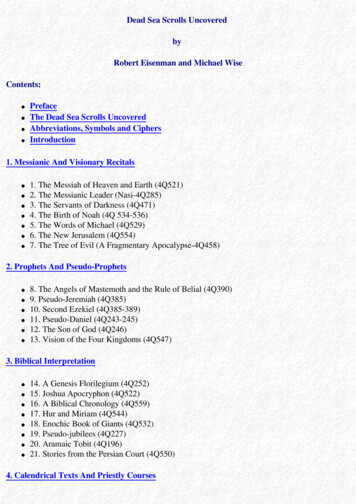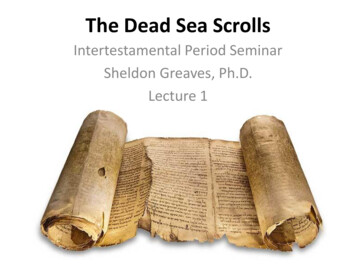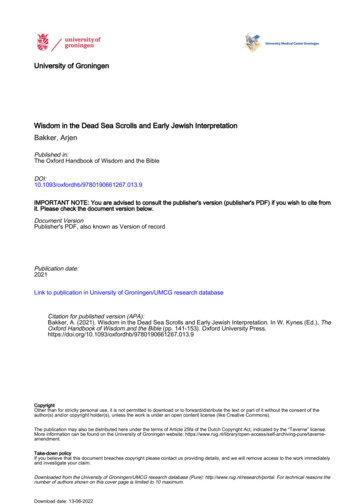
Transcription
University of GroningenWisdom in the Dead Sea Scrolls and Early Jewish InterpretationBakker, ArjenPublished in:The Oxford Handbook of Wisdom and the TANT NOTE: You are advised to consult the publisher's version (publisher's PDF) if you wish to cite fromit. Please check the document version below.Document VersionPublisher's PDF, also known as Version of recordPublication date:2021Link to publication in University of Groningen/UMCG research databaseCitation for published version (APA):Bakker, A. (2021). Wisdom in the Dead Sea Scrolls and Early Jewish Interpretation. In W. Kynes (Ed.), TheOxford Handbook of Wisdom and the Bible (pp. 141-153). Oxford University 67.013.9CopyrightOther than for strictly personal use, it is not permitted to download or to forward/distribute the text or part of it without the consent of theauthor(s) and/or copyright holder(s), unless the work is under an open content license (like Creative Commons).The publication may also be distributed here under the terms of Article 25fa of the Dutch Copyright Act, indicated by the “Taverne” license.More information can be found on the University of Groningen website: ing-pure/taverneamendment.Take-down policyIf you believe that this document breaches copyright please contact us providing details, and we will remove access to the work immediatelyand investigate your claim.Downloaded from the University of Groningen/UMCG research database (Pure): http://www.rug.nl/research/portal. For technical reasons thenumber of authors shown on this cover page is limited to 10 maximum.Download date: 13-06-2022
Wisdom in the Dead Sea Scrolls and Early Jewish InterpretationWisdom in the Dead Sea Scrolls and Early Jewish Inter pretationArjen BakkerThe Oxford Handbook of Wisdom and the BibleEdited by Will KynesPrint Publication Date: Mar 2021 Subject: Religion, Literary and Textual StudiesOnline Publication Date: Jan 2021 DOI: 10.1093/oxfordhb/9780190661267.013.9Abstract and KeywordsThis article argues that wisdom in the Dead Sea Scrolls is not a continuation of the bibli cal Wisdom tradition. What we see in the scrolls is rather a reinterpretation of biblicalWisdom Literature within new conceptual frameworks and within the broader context ofthe interpretive culture of Second Temple Judaism. One of the main aspects of this newversion of wisdom is that it is hidden and not available to just anyone. The emphasis onmystery and the hidden structures of time is shared by Wisdom texts from Qumran andfrom the Hellenistic world. Wisdom is omnipresent across Jewish traditions as it is inte grated with Torah, revelation, and prayer. The discovery of the Dead Sea Scrolls hasmade clear how deeply embedded wisdom was across genres and traditions.Keywords: wisdom, Dead Sea Scrolls, classification, ancient interpretation, wisdom and Torah, study, liturgy, mys tery, Hellenistic period, multilingualismTHE topic of wisdom has become a major theme in Dead Sea Scrolls scholarship in thelast two decades. This is mainly the result of the publication in the 1990s of a number offragmentary texts from Qumran Cave 4 that share literary features with biblical WisdomLiterature and have for this reason been classified as sapiential texts in the editions andtranslations. However, even before the publication of the Cave 4 materials it was evidentthat Wisdom was an important category in the newly found compositions. Texts from Cave1 such as the Rule of the Community (1QS) and the Thanksgiving Hymns (1QHa) are re plete with Wisdom terminology and have the highest esteem for the pursuit and attain ment of knowledge. The main question is how to situate the various forms of wisdom weencounter in the Dead Sea Scrolls within the broader landscape of Judaism in the Hel lenistic and early Roman periods.Building on recent developments in scholarship, this article argues that the Qumran sapi ential texts cannot be separated off from the broader corpus on account of their literaryform. In order to better understand the intricate wisdom concepts that are being devel oped in these compositions, we have to study the multitude of fragmentary texts side byside without insisting on strict distinctions in terms of literary genre or provenance (i.e.,Page 1 of 15PRINTED FROM OXFORD HANDBOOKS ONLINE (www.oxfordhandbooks.com). Oxford University Press, 2018. All RightsReserved. Under the terms of the licence agreement, an individual user may print out a PDF of a single chapter of a title inOxford Handbooks Online for personal use (for details see Privacy Policy and Legal Notice).Subscriber: University of Groningen; date: 04 October 2021
Wisdom in the Dead Sea Scrolls and Early Jewish Interpretationsectarian vs. non-sectarian). This will lead to the observation that rather than continuingthe biblical Wisdom tradition, texts found at Qumran perform a reinterpretation of Wis dom within the context of the broader intellectual culture of Judaism. To appreciate thiswider framework of early Jewish interpretation, it is important to look across the linguis tic boundaries of Hebrew, Aramaic, and Greek. Only by cultivating this broader outlookcan we gain more clarity on the ways in which intellectual traditions from the SecondTemple period reverberate in late antiquity.(p. 142)9.1 Questions of ClassificationThe discovery of Qumran texts that resemble biblical Wisdom Literature obviously raisesthe question of the relation between these two corpora. Are these texts really continuingthe Wisdom tradition that we already encounter in books of the Hebrew Bible? In order toaddress this question, we have to take a closer look at issues of taxonomy, not only interms of literary genre, but also regarding the supposed sectarian or non-sectarian prove nance of the texts.The editors of the Dead Sea Scrolls had to find ways of categorizing the newly discoveredfragmentary manuscripts. The editors had to sort thousands of fragments and reconstructmanuscripts that included many texts that were previously unknown to modern scholars(Tigchelaar 2010). Evidently, when characterizing and labelling the texts, familiar cate gories, especially those deriving from form-critical scholarship of the Hebrew Bible, wereused (Najman and Tigchelaar 2014). When it became clear that certain fragmentary textsshared formal features with compositions such as Proverbs, Job, Qohelet, and Ben Sira, itwas only too natural to label these as Wisdom compositions. Nonetheless, it was also ap parent that these works had features that did not fit within the traditional frame of Wis dom Literature.The category of Wisdom Literature is a modern scholarly construct (Weeks 2016). Biblicalscholars had developed this category on the basis of a set of characteristics shared bysome texts in the Hebrew Bible: terminology related to wisdom and knowledge, literaryforms associated with pedagogy, and a worldview that centered on the notion of a perfect ly ordered creation. Texts that had been unearthed in Mesopotamia and Egypt made useof similar literary forms and presented a worldview and concepts that corresponded tothose found in biblical Wisdom Literature. For this reason, scholars argued that thesewritings were part of an international literary tradition that functioned in the education ofscribal elites. These basic parameters have been much discussed. It has proved difficultto clearly define criteria and delineate the corpus. Some scholars have even argued thatthe category of Wisdom Literature should be abandoned altogether (Kynes 2019).The sapiential texts from Qumran further complicate the discussion on the category ofWisdom Literature. It is obvious that the biblical Wisdom books were considered of greatimportance by the authors of the Qumran texts: the typical terminology of biblical Wis dom is applied profusely and its literary forms are emulated. However, this terminology isimbued with meanings that are alien to classical Wisdom and, although we can recognizePage 2 of 15PRINTED FROM OXFORD HANDBOOKS ONLINE (www.oxfordhandbooks.com). Oxford University Press, 2018. All RightsReserved. Under the terms of the licence agreement, an individual user may print out a PDF of a single chapter of a title inOxford Handbooks Online for personal use (for details see Privacy Policy and Legal Notice).Subscriber: University of Groningen; date: 04 October 2021
Wisdom in the Dead Sea Scrolls and Early Jewish Interpretationaspects of a worldview that is focused on cosmic order, the conceptual framework inwhich these notions are embedded is rather different. Moreover, the literary genres asso ciated with Wisdom Literature are mixed with genres known from other types of litera ture (Kister 2004).The provenance of the Qumran sapiential texts is a matter of dispute, namely whether ornot these texts were sectarian. The label “sectarian” here refers to texts that were(p. 143) composed by the communities that owned the Dead Sea Scrolls. The nature andstructure of these communities, as well as their relation to the site of Qumran and theschool of the Essenes, continue to be debated (Goodman 1995; Mason 2007; Collins2010). But despite the lack of consensus and clarity, many scholars still presume that it ispossible to differentiate between sectarian and non-sectarian texts and argue that theWisdom texts from Qumran belong to the non-sectarian division. Other scholars claimthat the same texts are sectarian. This bifurcation of views has led to an impasse in schol arship on Qumran Wisdom to the point that it is difficult to have a meaningful conversa tion between scholars working on either side of the fence, since they read the fragmentsin radically different ways.When the fragments resembling biblical Wisdom were first studied, the Qumran-Essenehypothesis and the sectarian nature of the community were still largely taken for grant ed. John Strugnell, who was responsible for editing the largest and most widely attestedWisdom text found at Qumran (4QInstruction), assumed in an early publication that thistext contained moral teachings of the Qumran sect (Strugnell et al. 1956). However, whenhe published the official edition of the 1Q and 4Q manuscripts of 4QInstruction, he hadchanged his view and claimed that this was a non-sectarian composition that was com posed before the sect had been founded (Strugnell et al. 1999).This reversal of opinion results from a major shift in the categorization of the Dead SeaScrolls that began in the late 1970s (Newsom 1990; Dimant 2011; Tigchelaar 2012). Inthe early years after the discoveries, scholars generally assumed that all previously un known texts were products of the Qumran community. But the gradual publication of newtexts revealed a large variety among the compositions. Many of these texts did not dis play the sectarian markers that scholars had come to associate with the community’s lit erary production. Since the biblical texts were obviously not composed by this communi ty, why would there not be other (non-biblical) texts in their library that also had beencomposed by others?The fragmentary Wisdom texts by and large do not employ terminology that refers to thecommunities of the Damascus Document and the Community Rule. Moreover, 4QInstruc tion, the most important of the Wisdom texts, gives advice on issues relating to property,marriage, and offspring. By contrast, the Community Rule describes how members re nounce private property. The absence of women in the Rule has been taken by manyscholars as an indication that the members were unmarried, just like the Essenes de scribed by Philo and Josephus. For these reasons, it was argued that the sapiential textsfrom Qumran were not composed by the sectarian community, but were merely copiedPage 3 of 15PRINTED FROM OXFORD HANDBOOKS ONLINE (www.oxfordhandbooks.com). Oxford University Press, 2018. All RightsReserved. Under the terms of the licence agreement, an individual user may print out a PDF of a single chapter of a title inOxford Handbooks Online for personal use (for details see Privacy Policy and Legal Notice).Subscriber: University of Groningen; date: 04 October 2021
Wisdom in the Dead Sea Scrolls and Early Jewish Interpretationand preserved as part of their library. These texts would then be the products of Wisdomteachers representing an ongoing sapiential tradition that was part of the “mainstream”intellectual world of Second Temple Judaism (Harrington 1996; Collins 1997; Goff 2007;Lange 2010; Kampen 2011).Scholars arguing for the non-sectarian provenance of the Qumran Wisdom texts do recog nize the shared terminology in sectarian texts such as the Rule of the Community and theThanksgiving Hymns. This is usually explained as influence of the sapiential texts on thesectarian texts: the sectarian composers had 4QInstruction (p. 144) in their library andadopted its terms and concepts. The problem with this line of reasoning is that we haveno way of proving that the sapiential texts were actually composed prior to the sectarianones. The only argument for dating these compositions earlier is the assumption that theyhad not been written by the sect and must therefore have been written before its founda tion. But there is no reason to exclude the possibility that the community adopted con temporaneous compositions from the outside. Moreover, our criteria are rather shaky.There is a significant degree of terminological overlap. Why could this vocabulary only beused to prove literary dependence and not shared provenance?For precisely this reason, other scholars have argued that the sapiential texts from Qum ran are literary products of the community. Both Devorah Dimant (2011) and MenahemKister (2009) have pointed to a large number of distinctive phrases and concepts that areshared by the Qumran Wisdom texts and compositions that are typically associated withthe community. In their judgment, the pervasive presence of sectarian vocabulary in theWisdom texts indicates that these should indeed be regarded as sectarian. The divergentclassifications of the Wisdom texts make discussion between scholars on either side of thedivide difficult. Since context is so crucial for the interpretation of fragmentary texts,scholars who classify the Wisdom texts as sectarian are in some sense reading entirelydifferent compositions than those scholars who classify the same texts as non-sectarian.This impasse can be overcome by recognizing that the strict dichotomy of sectarian andnon-sectarian compositions cannot ultimately be sustained, and is an obstacle to researchthat casts a wider net on Jewish Wisdom traditions in the Greco-Roman period. The ab sence of sectarian features in a text does not necessarily mean that it was written by adifferent group, since vocabulary and style can also be dictated by literary genre. More over, we can never be sure that the lost portions of a text did not contain sectarian fea tures. But more fundamentally, there is a problem with our criteria and our categories.For in order to define which texts are sectarian and which texts are not, we need to havea clear notion of what we mean by “sectarian,” what the sect looked like, and in whichways it deviated from other Jewish communities. Scholarship has no clarity on these is sues at present. The publication of the entire corpus of the Dead Sea Scrolls is relativelyrecent and further research will certainly result in clearer answers to these questions.But if we impose preliminary distinctions on the corpus, we will continue to follow the cir cular paths that we have ourselves created.Page 4 of 15PRINTED FROM OXFORD HANDBOOKS ONLINE (www.oxfordhandbooks.com). Oxford University Press, 2018. All RightsReserved. Under the terms of the licence agreement, an individual user may print out a PDF of a single chapter of a title inOxford Handbooks Online for personal use (for details see Privacy Policy and Legal Notice).Subscriber: University of Groningen; date: 04 October 2021
Wisdom in the Dead Sea Scrolls and Early Jewish Interpretation9.2 Reinterpreting WisdomIn order to understand the concept of wisdom in the Dead Sea Scrolls all texts should bestudied in conjunction, whether they have been labelled as Wisdom compositions or not,and whether they have been classified as sectarian or non-sectarian. It is questionablewhether the Qumran sapiential texts can be seen as representatives of an (p. 145) ongoingtradition of Wisdom Literature that is cultivated by circles of scribes. Rather, as Mena hem Kister observes, “The continuity of the biblical wisdom tradition, often presumed be cause of the similarity in terminology or phraseology, is just as often an illusion” (Kister2004, 19). What we see in the scrolls is rather a reinterpretation of biblical Wisdom Liter ature within new conceptual frameworks and within the broader context of the interpre tive culture of Second Temple Judaism.One of the main aspects of this new version of wisdom is that it is hidden and not avail able to everyone. Whereas in the book of Proverbs Lady Wisdom raises her voice andcries out by the city gates (Prov 8:1–3), the texts from Qumran tend to assume that wis dom is concealed and that only a select group of initiates have access. Throughout 4QIn struction the addressee is called a mebin, someone who understands, and is told: “yourear has been opened for the secret of being (raz nihyeh).” The meaning of the enigmaticphrase raz nihyeh is much disputed and will briefly be discussed below. But the elementsof secrecy and the need of initiation are obvious and an important aspect of wisdom in thescrolls.To a large extent this secret knowledge is focused on understanding the meaning of scrip tures. This meaning is not accessible to just anyone who reads the text, but has to beteased out by the right person, within the right community, and with the right method.Wisdom consists in uncovering the “hidden things” ( )נסתרות of the scriptures. The textsfrom Qumran are replete with references to biblical texts and allude to specific interpre tations. This approach to interpreting the scriptures is very much in line with what JamesKugel (1998) observed about interpretation in ancient Judaism more generally: the text isfundamentally regarded as cryptic and needs to decoded by the reader. This suggests thatWisdom features in the Dead Sea Scrolls may often attest to reinterpretation rather thanto the continuation of a tradition.A good example is the term mebin. The form occurs in Proverbs to describe someone whounderstands situations and has insight into wisdom teachings. The occurrence of thisform in Proverbs may have influenced its usage in 4QInstruction but it is important torecognize the discontinuity in usage. In Proverbs the term never functions as a form ofaddress for the disciple, while 4QInstruction consistently addresses its audience asmebin. How can this new usage of the term be explained?In Proverbs we encounter the admonition, “And now, sons ( )בנים , listen to me.” In frag mentary Qumran texts we find a remarkable variation on this form: “And now, under standing one/ones (mebin/mebinim), listen to me” (4Q303, 4Q525). The authors used theadmonition from Proverbs, but interpreted the plural בנים not as “sons” but as a participlePage 5 of 15PRINTED FROM OXFORD HANDBOOKS ONLINE (www.oxfordhandbooks.com). Oxford University Press, 2018. All RightsReserved. Under the terms of the licence agreement, an individual user may print out a PDF of a single chapter of a title inOxford Handbooks Online for personal use (for details see Privacy Policy and Legal Notice).Subscriber: University of Groningen; date: 04 October 2021
Wisdom in the Dead Sea Scrolls and Early Jewish Interpretationof the verb בין , “to understand,” and applied it in the hifil pattern (Kister 2000). The sametwist occurs in a wordplay in Ben Sira: “Wisdom educates her sons ( )בניה and she admon ishes all those who understand her ( ( ”)מבינים בה Sir 4:11). It seems that a similar reinter pretation of sapiential terminology lies behind the usage of mebin as a form of address in4QInstruction. Throughout Proverbs the student of wisdom is addressed as son ( בנים , )בני .But 4QInstruction discerns a deeper meaning behind this trope: the student of wisdom issomeone who understands secrets and mysteries (Bakker 2020).The sapiential features of Qumran texts should be seen in the broader context ofrewriting, interpreting, and emulating authoritative writings. The communities behindthese manuscripts did not study the Wisdom books of the Bible separately, but in conjunc tion with other texts. This is precisely how Ben Sira describes the daily occupation of thesage:(p. 146) who devotes his soul,and who thinks about the Law of the Most High.He will seek out the wisdom of all the ancients,and he will be occupied with prophecies.He will preserve the narrative of famous men,and he will penetrate into the twists of illustrations.He will seek out the obscurities of proverbs,and he will be engaged with the riddles of illustration.(Sir 38:34–39:3, transl. Wright, NETS)The pursuit of wisdom is not restricted to the study of proverbs and riddles, but is also di rected towards prophecies and, most prominently, the Torah. The recycling and reinter pretation of terminology and literary forms from biblical Wisdom Literature should beseen in this context. In the course of the Second Temple period a collection of canonicalwritings emerged, and although this was not a closed canon, it is clear that these writingswere held in reverence and were scrutinized. The content of wisdom is determined to alarge extent by these writings, or more precisely, by the interpretation of these writingsand the correct understanding of their hidden meaning. But it is important to emphasizethat other books that never became part of the Bible were studied as well.The Law of Moses obviously takes a central place in this interpretive enterprise. Ben Siraplaces the Torah at the top of his list of holy writings and elsewhere he famously statesthat all the fruits of wisdom are embedded “in the book of the covenant of the Most High,a Law that Moses commanded us” (Sir 24:23). There is an elaborate and ongoing discus sion on the relationship between Wisdom and Law (Schipper and Teeter 2013). Manyscholars argue that Torah became incorporated into Wisdom traditions. But Wisdom fromthe late Second Temple period cannot be separated from the broader interpretive cultureand literary production of Judaism. In terms of authority, it is no doubt more correct tosay that wisdom “is subsumed by Torah” (Tooman 2013, 227; cf. Kister 2004). But weshould note that the processes of reinterpretation are reciprocal and that various forms ofliterature leave their mark on the ways in which the entire textual corpus is read.Page 6 of 15PRINTED FROM OXFORD HANDBOOKS ONLINE (www.oxfordhandbooks.com). Oxford University Press, 2018. All RightsReserved. Under the terms of the licence agreement, an individual user may print out a PDF of a single chapter of a title inOxford Handbooks Online for personal use (for details see Privacy Policy and Legal Notice).Subscriber: University of Groningen; date: 04 October 2021
Wisdom in the Dead Sea Scrolls and Early Jewish InterpretationThe concept of Torah is extremely difficult to pin down and it is not clear to what extent“the Law of the Most High” or the “Law that Moses commanded us” are to be identifiedwith the books of the Pentateuch, or with a more abstract notion of divine law (Levenson1987). In order to get a better grasp of the entanglement of Torah and wisdom, it is help ful to examine the way in which both are intertwined with practice and observance. Thisis exemplified in a beautiful way in a passage that praises the wise with a series of beati tudes and concludes:(p. 147)Happy is the man who has reached wisdom,and walks in the law of the Most High,and sets his heart to her ways.He controls himself in her punishments,and always willingly accepts her afflictions.He does not forsake her in the distress of [his] cruci[ble],and at the time of anguish he will not leave her.He does not forget her [on the day] of terror,and in humbling himself, he will not despise her.Rather, he meditates on her continually,and in his distress he speaks about [her].(4Q525 2 ii 3–6)Wisdom and law are placed on an equal footing and the sage lives by their instructions.He is educated by holding fast to wisdom and any unfortunate events in his life are re garded as admonishment or trial. This implies that wisdom is not only seen as an object ofknowledge, but also as an agent in the world: she inflicts suffering on the sage in order totrain him and purify him, like metal in a crucible.According to 4Q525 the sage constantly meditates on wisdom. There is a direct allusionhere to Joshua 1:8, “This book of the Law shall not depart out of your mouth, you shallmeditate on it day and night” (NRSV). This verse had a great impact and is also reflectedin Psalm 1, Ben Sira 6, and the Rule of the Community (1QS VI 6). It is reused in a re markable way in 4QInstruction, which tells the mebin:[Day] and night meditate on the mystery of being,and study continuouslyAnd then you will know truth and iniquity,wisdom and [foll]y you will un[dersta]nd.(4Q417 1 6–7)The phrase “mystery of being” (raz nihyeh) occurs frequently in 4QInstruction and is alsoattested in the Rule of the Community and 4QMysteries. It is one of the most elusive con cepts in the Dead Sea Scrolls. The allusion to Joshua 1:8 indicates that raz nihyeh relatesto the Torah, and the same can be inferred from 4QInstruction’s many allusions to thePage 7 of 15PRINTED FROM OXFORD HANDBOOKS ONLINE (www.oxfordhandbooks.com). Oxford University Press, 2018. All RightsReserved. Under the terms of the licence agreement, an individual user may print out a PDF of a single chapter of a title inOxford Handbooks Online for personal use (for details see Privacy Policy and Legal Notice).Subscriber: University of Groningen; date: 04 October 2021
Wisdom in the Dead Sea Scrolls and Early Jewish InterpretationPentateuch, its discussion of legal matters (Schiffman 2004), and its reference to Mosaicrevelation (4Q418 184 1).The concept of the “mystery of being” is similar to the concept of wisdom in Proverbs andJob in the sense that it organizes the cosmos and society (Lange 1995). But there is amuch stronger emphasis on temporality in raz nihyeh: it is the hidden force behind histo ry and causes situations to develop and change both on a small scale and on a large scale.The use of various forms of the root “( היה to be,” “to happen”) in the Dead Sea Scrolls at tests to an intricate reflection on the concept time and the phrase raz nihyeh could alsobe translated as the “secret of time” (Bakker 2021).The raz nihyeh can be examined by studying the words of Moses and the prophets and byuncovering their hidden meaning. But other mantic techniques provide access to the mys tery of being as well, especially astrology. More than once the mebin is told (p. 148) tostudy horoscopes in order to understand the hidden structures of social relationships(Morgenstern 2000; Schmidt 2006). The raz nihyeh is the hidden plan of God and allowsinsight into the divisions and workings of good and evil in the world. There is a close cor respondence between the vocabulary and concepts in 4QInstruction and in the Treatise ofthe Two Spirits, in columns III and IV of 1QS (Lange 1995; Tigchelaar 2001). This indi cates that the teachings of these texts are related and can be mutually illuminating. Butraz nihyeh refers to a broader concept that encompasses all possible forms of knowledge.The instructions to the mebin are repeatedly reinforced by the statement: “as He hasopened your ear for the mystery of being.” The teachings presented are accessible tosomeone who was given insight into heavenly mysteries. But this divine gift to the mebindoes not release him from the obligation to acquire knowledge himself. To the contrary,throughout 4QInstruction the addressees are incited to study and gather knowledge,whatever the circumstances:If you are poor, do not say “I am poor so w[hy] should I study wisdom?”Bring your shoulder under all instruction,and with every [ ] refine your mind,and with abundance of insight your thoughts.Study the mystery of being,and consider all the ways of truth,and all the roots of iniquity you must contemplate.Then you will know what is bitter for a man,and what is sweet for a person.(4Q416 iii 12–15 par 4Q418 9 9a–c 13–16)As in the passage from 4Q525 quoted above, the pursuit of wisdom is presented as a con tinuous exercise in which the sage is tested and in which his mind is purified. The com mand in Joshua 1:8 to meditate on the law day and night is taken literally and the stu dents are admonished to study continuously, by day and by night. In another fragmentfrom 4QInstruction the ideal of the uninterrupted pursuit of knowledge is exemplified byangels who chase after insight without ever becoming tired or hungry (4Q418 69 ii). ThePage 8 of 15PRINTED FROM OXFORD HANDBOOKS ONLINE (www.oxfordhandbooks.com). Oxford University Press, 2018. All RightsReserved. Under the terms of the licence agreement, an individual user may print out a PDF of a single chapter of a title inOxford Handbooks Online for personal use (for details see Privacy Policy and Legal Notice).Subscriber: University of Groningen; date: 04 October 2021
Wisdom in the Dead Sea Scrolls and Early Jewish Interpretationstudents of wisdom are admonished to follow this example. The wisdom they pursue liesbeyond the limits of human comprehension and for this reason they are required to tran scend human limitations, such as the need for food and rest, in order to chase afterknowledge continually. The pursuit of heavenly wisdom requires
Keywords: wisdom, Dead Sea Scrolls, classification, ancient interpretation, wisdom and Torah, study, liturgy, mys tery, Hellenistic period, multilingualism THE topic of wisdom has become a major theme in Dead Sea Scrolls scholarship in the last two decades. This is mainly the result of the publication in the 1990s of a number of
